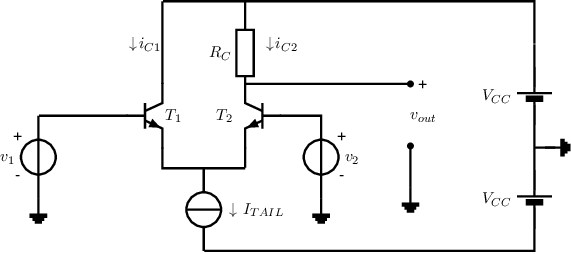Exercise 8.4 A differential pair
In the circuit, the two BJTs in the differential pair (
and )
are identical. The transistors can be assumed to operate in active forward, for which
. In this operating region,
the output resistance
of the BJTs can be assumed to be infinitely large. Furthermore,
, the current gain
is finite and much
larger than unity, ,
,
and
.

-
a)
- Assume that the base of
is connected to ground ().
Derive a relation between the common-mode input signal
and .
-
b)
- Assuming that ,
derive expressions for the collector currents of the two BJTs.
-
c)
- Derive (or approximate) the value of
in order to get ,
for .
-
d)
- Derive (or approximate) the value of
in order to get ,
for .
-
e)
- Estimate the (absolute) maximum voltage swing across .
-
f)
- Estimate the (absolute) minimum value of
of .
-
g)
- Derive an expression for the slew-rate of the circuit in case there is a capacitor
in parallel with .
Calculate the numerical value of the slew-rate for .
-
h)
- Derive an expression for the small-signal voltage gain .
-
i)
- Using a feedback network, we now set .
Derive an expression for the differential input voltage of the circuit ()
as a function of .
in the derivation, you may use the fact that the (small signal) voltage gain
is known: that was derived in the previous question.

